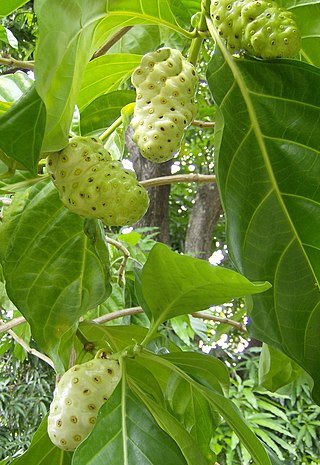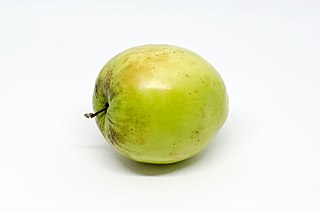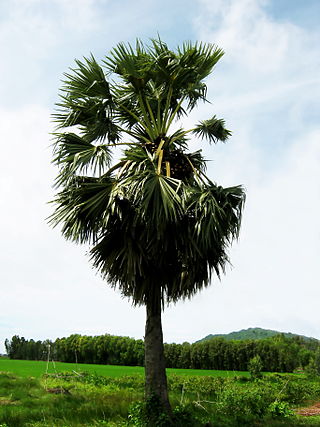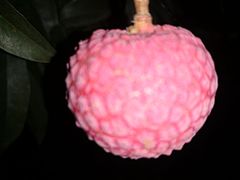
Citrus is a genus of flowering trees and shrubs in the rue family, Rutaceae. Plants in the genus produce citrus fruits, including important crops such as oranges, lemons, grapefruits, pomelos, and limes. The genus Citrus is native to South Asia, East Asia, Southeast Asia, Melanesia, and Australia. Various citrus species have been used and domesticated by indigenous cultures in these areas since ancient times. From there its cultivation spread into Micronesia and Polynesia by the Austronesian expansion ; and to the Middle East and the Mediterranean via the incense trade route, and onwards to Europe and the Americas.

A mango is an edible stone fruit produced by the tropical tree Mangifera indica. It is believed to have originated in southern Asia, particularly in eastern India, Bangladesh, and the Andaman Islands. M. indica has been cultivated in South and Southeast Asia since ancient times resulting in two types of modern mango cultivars: the "Indian type" and the "Southeast Asian type". Other species in the genus Mangifera also produce edible fruits that are also called "mangoes", the majority of which are found in the Malesian ecoregion.

Rambutan is a medium-sized tropical tree in the family Sapindaceae. The name also refers to the edible fruit produced by this tree. The rambutan is native to Southeast Asia. It is closely related to several other edible tropical fruits, including the lychee, longan, pulasan, and quenepa.

Dimocarpus longan, commonly known as the longan and dragon's eye, is a tropical tree species that produces edible fruit. It is one of the better-known tropical members of the soapberry family Sapindaceae, to which the lychee and rambutan also belong. The fruit of the longan is similar to that of the lychee, but less aromatic in taste. It is native to tropical Asia and China.

Lychee is a monotypic taxon and the sole member in the genus Litchi in the soapberry family, Sapindaceae.

The persimmon is the edible fruit of a number of species of trees in the genus Diospyros. The most widely cultivated of these is the kaki persimmon, Diospyros kaki – Diospyros is in the family Ebenaceae, and a number of non-persimmon species of the genus are grown for ebony timber. In 2019, China produced 75% of the world total of persimmons.

Mangosteen, also known as the purple mangosteen, is a tropical evergreen tree with edible fruit native to tropical lands surrounding the Indian Ocean. Its origin is uncertain due to widespread prehistoric cultivation. It grows mainly in Southeast Asia, southwest India and other tropical areas such as Colombia and Puerto Rico, where the tree has been introduced.

Citrus limetta, alternatively considered to be a cultivar of Citrus limon, C. limon 'Limetta', is a species of citrus, commonly known as mousami, musami, sweet lime, sweet lemon, and sweet limetta, it is a member of the sweet lemons. It is small and round like a common lime in shape. It is a cross between the citron and a bitter orange.

The loquat is a large evergreen shrub or tree grown commercially for its orange fruit and for its leaves, which are used to make herbal tea. It is also cultivated as an ornamental plant.

Morinda citrifolia is a fruit-bearing tree in the coffee family, Rubiaceae. Its native range extends across Southeast Asia and Australasia, and was spread across the Pacific by Polynesian sailors. The species is now cultivated throughout the tropics and widely naturalized. Among some 100 names for the fruit across different regions are the more common English names of great morinda, Indian mulberry, noni, beach mulberry, vomit fruit, awl tree and cheese fruit.

Annona squamosa is a small, well-branched tree or shrub from the family Annonaceae that bears edible fruits called sugar-apples or sweetsops. It tolerates a tropical lowland climate better than its relatives Annona reticulata and Annona cherimola helping make it the most widely cultivated of these species. Annona squamosa is a small, semi-(or late) deciduous, much-branched shrub or small tree 3 to 8 metres tall similar to soursop.

Ziziphus mauritiana, also known as Indian jujube, Indian plum, Chinese date, Chinee apple, ber and dunks is a tropical fruit tree species belonging to the family Rhamnaceae. It is often confused with the closely related Chinese jujube, but whereas Z. jujuba prefers temperate climates, Z. mauritiana is tropical to subtropical.

Aegle marmelos, commonly known as, bael, also Bengal quince, golden apple, Japanese bitter orange, stone apple or wood apple, is a species of tree native to the Indian subcontinent and Southeast Asia. It is present in India, Pakistan, Bangladesh, Sri Lanka, and Nepal as a naturalized species. The tree is considered to be sacred by Hindus and Buddhists.

Dinajpur district is a district in the Rangpur Division of northern Bangladesh. Dinajpur is the largest district among all sixteen northern districts of Bangladesh.

Pouteria caimito, the abiu, is a tropical fruit tree originating in the Amazonian region of South America. It grows to an average of 10 metres (33 ft) high, and can grow as high as 35 metres (115 ft) under good conditions. Its fruits' shape varies from round to oval, pointed at the distal end. When ripe, it has smooth, bright yellow skin and has one to four ovate seeds. The inside of the fruit is translucent and white. It has a creamy and jelly-like texture and its taste is similar to the sapodilla — a sweet caramel custard. The abiu tree is part of the family Sapotaceae and is very similar in appearance to the canistel.

Terminalia chebula, commonly known as black- or chebulic myrobalan, is a species of Terminalia, native to South Asia from India and Nepal east to southwest China (Yunnan), and south to Sri Lanka, Malaysia, and Vietnam.

Borassus flabellifer, commonly known as doub palm, palmyra palm, tala or tal palm, toddy palm, lontar palm, wine palm, or ice apple, is a fan palm native to South Asia and Southeast Asia. It is reportedly naturalized in Socotra and parts of China.

Lychee wine is a full-bodied Chinese dessert wine made of 100% lychee fruit. This wine has a golden colour and rich, sweet taste. It is usually served ice cold, either straight up or on the rocks with food. Lychee wine is believed to pair better with shellfish and Asian cuisine than with heavier meat dishes. This refreshing beverage can also be used as a cocktail mixer paired with other spirits.

Baccaurea motleyana is a species of fruit and fruit tree which grows wild in parts of Southeast Asia and is cultivated for its fruit in Bangladesh, Indonesia, Thailand and Peninsular Malaysia. Its common names include rambai and rambi, and in Thai language mafai-farang. In the Bengali language the fruit is known as bugi as local language in Narsingdi like lotka, lotkon or bugi in Bengali locally (লটকা/লটকন/বুগি), in the Assamese language it is known as leteku (লেটেকু). This is a tree generally growing to 9 to 12 meters in height with a short trunk and a broad crown. The evergreen leaves are shiny green on the upper surface and greenish-brown and hairy underneath. Each leaf is up to 33 centimeters (13 in) long and 15 centimeters (5.9 in) wide. The species is dioecious, with male and female flowers growing on separate individuals. Both types of flowers are fragrant and have yellow sepals. The staminate racemes are up to 15 centimeters (5.9 in) long and the pistillate inflorescences may reach 75 centimeters (30 in) in length. The fruits are each 2 to 5 centimeters long and about two wide and grow in strands. Each fruit has velvety pinkish, yellow, or brown skin which wrinkles at ripening and is filled with whitish pulp containing 3 to 5 seeds. The pulp is sweet to acid in taste. They may be eaten raw or cooked or made into jam or wine. The tree is also used for shade and low-quality wood.
Kamalapur Red Banana is a special variety of Red banana which is exclusively grown in the valley of Kamalapur village and its surrounding areas in Kalaburagi district of Karnataka, India. It is known as a "rich man's fruit" as it is marketed at a higher price compared to other varieties of banana due to greater inputs in farming with fertilizer, water, and workforce. While its skin is red coloured, the pulp is creamish in colour with an enjoyable taste. It has a high calorie value with Vitamin C and B6, which makes it a health food.






















